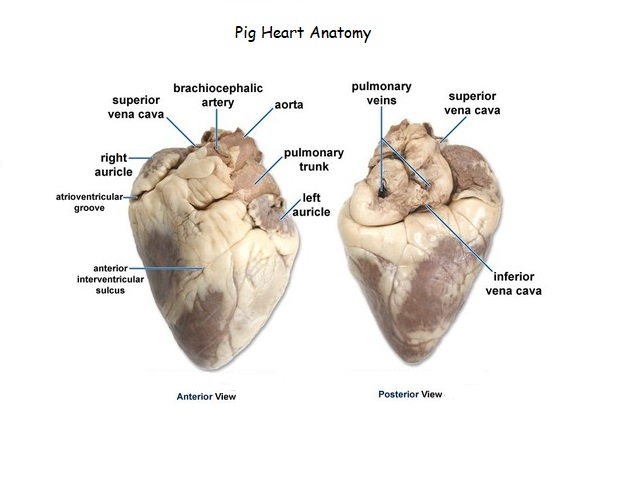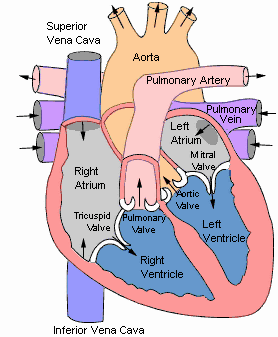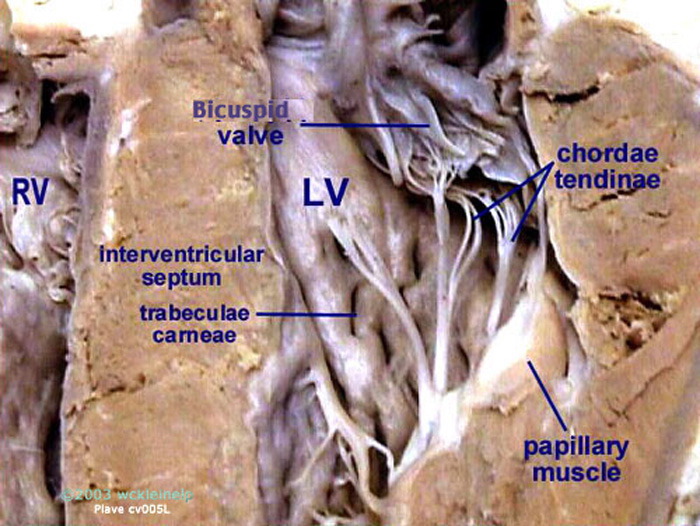Heart Dissection

|
Heart Dissection |
 |
Introduction
Mammals have four-chambered hearts and
double circulation. This means that it has two separate circuits and blood
passes through the heart twice: the pulmonary circuit is between the heart
and lungs, the systemic circuit is between the heart and the other organs. The heart of a bird or mammal has two atria and two
completely separated ventricles. The double-loop circulation is similar to
amphibians and reptiles, but the oxygen-rich blood is completely separated from
oxygen-poor blood. The left side of the heart handles only oxygenated blood, and
the right side receives and pumps only deoxygenated blood. With no mixing of the
two kinds of blood, and with a double circulation that restores pressure after
blood has passed through the lung capillaries, delivery of oxygen to all parts
of the body for cellular respiration is enhanced.
As endotherms, which use heat released from metabolism to warm the body, mammals require more oxygen per gram of body weight than other vertebrates of equal size. Birds (Class Aves) and mammals (Class Mammalia) descended from different reptilian ancestors, and their four-chambered hearts evolved independently - an example of convergent evolution. The four-chambered heart is more efficient than the two- or three-chambered heart because the blood that is oxygen-poor never mixes with the blood that is oxygen-rich.
Objective
Using a pig heart, students will
observe the major chambers, valves, and vessels of the heart and be able to
describe the circulation of blood through the heart to the lungs and back and
out to the rest of the body. (The
pig heart is used because it is very similar to the human heart in structure,
size, & function, and are easily obtained from local butcher shops or meat
packing plants. NO, THIS HEART IS NOT FROM SMITHFIELD'S.)
Materials
Dissecting pan, dissecting tools, and
one pig heart.
Video: Pig Heart Dissection: click HERE to watch the video
Study Guide: click HERE for a study guide to help you prepare for the lab quiz
Procedure - External Structure
Place a heart in a dissecting pan & rinse off the excess preservative with tap water. Pat the heart dry with paper towels.
Examine the heart and locate the thin membrane or pericardium that still covers the heart. The pericardium or pericardial sac, is a double-layered closed sac that surrounds the heart and anchors it. The pericardium consists of two tissues layers - the visceral pericardium that covers the surface of the heart & the parietal pericardium covering the inner surface of the parietal sac. These two tissue layers are continuous with each other where the vessels enter or leave the heart. The slender gap between the parietal & visceral surfaces is the pericardial cavity & is filled with fluid to reduce friction between the layers as the heart pumps.
After examining the pericardium, carefully remove this tissue. Located below the pericardium is the muscle of your heart called the myocardium. Most of the myocardium is located in the lower two chambers of the heart called ventricles. Near the right and left atria are two flap-like structures. These are called the right auricle and the left auricle. They resemble "ear-like" pouches. The function of these structures is to collect the blood from the vena cavae and pulmonary veins before the blood enters the right and left atrium. Older anatomy texts did not signify a difference between the words "auricle" and "atria", but newer texts have made the determination that these are two different anatomical structures.
See the diagrams below.


Locate the tip of the heart or the apex. Only the left ventricle extends all the way to the apex.
Place the heart in the dissecting pan so that the front or ventral side is towards you ( the major blood vessels are on the top and the apex is down). The front of the heart is recognized by a groove that extends from the right side of the broad end of the heart diagonally to a point above & to your left of the apex.

Front or Ventral Side of the Heart

The heart is now in the pan in the position it would be in a body as you face the body. Locate the following chambers of the heart from this surface:
Left atria - upper chamber to your right
Left ventricle - lower chamber to your right
Right atria - upper chamber to your left
Right ventricle - lower chamber to your left

While the heart is still in this position in the dissecting pan, locate these blood vessels at the broad end of the heart:
Coronary artery - this blood vessel lies in the groove on the front of the heart & it branches over the front & the back side of the heart to supply fresh blood with oxygen & nutrients to the heart muscle itself.
Pulmonary artery - this blood vessel branches & carries blood to the lungs to receive oxygen & can be found curving out of the right ventricle (upper chamber to your left)
Aorta - major vessel located near the right atria & just behind the pulmonary arteries to the lungs. This is the largest artery (diameter) in the body because it handles the largest volume of blood. If it would be smaller, the blood pressure would be too great and possibly burst a smaller blood vessel. Locate the curved part of this vessel known as the aortic arch. Branching from the aortic arch is a large artery that supplies blood to the upper body.
Pulmonary veins - these vessels return oxygenated blood from the right & left lungs to the left atrium (upper chamber on your right)
Inferior & Superior Vena Cava - these two blood vessels are located on your left of the heart and connect to the right atrium (upper chamber on your left). Deoxygenated blood enters the body through these vessels into the right receiving chamber. Use your probe to feel down into the right atrium. These vessels do not contain valves to control blood flow.
Procedure - Internal Anatomy:
Use scissors to cut through the side of the pulmonary artery and continue cutting down into the wall of the right ventricle. Be careful to just cut deep enough to go through the wall of the heart chamber. (Your cutting line should be above & parallel to the groove of the coronary artery.)
With your fingers, push open the heart at the cut to examine the internal structure. If there is dried blood inside the chambers, rinse out the heart.

Locate the right atrium. Notice the thinner muscular wall of this receiving chamber.
Find where the inferior & superior vena cava enter this chamber & notice the lack of valves.
Locate the valve that between the right atrium and right ventricle. This is called the tricuspid valve. The valve consists of three leaflets & has long fibers of connective tissue called chordae tendinae that attach it to papillary muscles of the heart. This valve allows blood flow from the right atrium into the right ventricle during diastole (period when the heart is relaxed). When the heart begins to contract (systole phase), ventricular pressure increases until it is greater than the pressure in the atrium causing the tricuspid to snap closed.

Use your fingers to feel the thickness of the right ventricle and its smooth lining. Also note the network of irregular muscular cords on the inner wall of this chamber. When comparing the myocardium thickness of the atria to the thickness of the ventricles you will see that the ventricle myocardium is much thicker. This is because the ventricles have to physically pump or push the blood a much farther distance than the atria. Thicker walls are needed to prevent tears or ruptures in the tissues as they ventricles contract and pump the blood.
Find the septum on the right side of the right ventricle. This thick muscular wall separates the right & left pumping ventricles from each other.
Inside the right ventricle, locate the pulmonary artery that carries blood away from this chamber. Find the one-way valve called the pulmonary valve that controls blood flow away from the right ventricle at the entrance to this blood vessel.
Using your scissors, continue to cut open the heart. Start a cut on the outside of the left atrium downward into the left ventricle cutting toward the apex to the septum at the center groove. Push open the heart at this cut with your fingers & rinse out any dried blood with water.
Examine the left atrium. Find the openings of the pulmonary veins form the lungs. Observe the one-way, semi-lunar valves at the entrance to these veins.
Inside this chamber, look for the valve that controls blood flow between the upper left atrium and lower left ventricle. This valve is called the bicuspid or mitral valve. This valve consists of two leaflets & blood flows from the left atrium into the left ventricle during diastole.
Examine the left ventricle. Notice the thickness of the ventricular wall. This heart chamber is responsible for pumping blood throughout the body.
Using your scissors, cut across the left ventricle toward the aorta & continue cutting to expose the valve.
Count the three flaps or leaflets on this valve leading from the left ventricle into the aorta and note their half-moon shape. This is called the aortic valve.
Using scissors, cut through the aorta and examine the inside. Find the hole or coronary sinus in the wall of this major artery. This leads into the coronary artery which carries blood to and nourishes the heart muscle itself.
Answer the questions on your lab report on JupiterEd.

When you have finished dissecting the heart, dispose of the heart as your teacher advises and clean, dry, and return all dissecting equipment to the proper area.